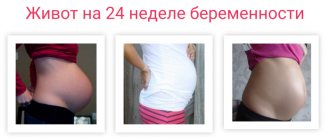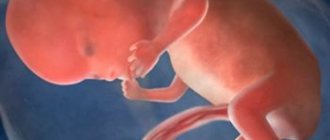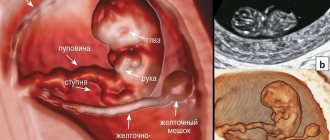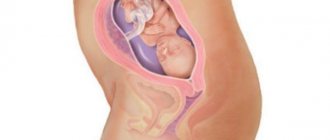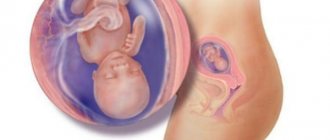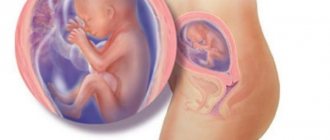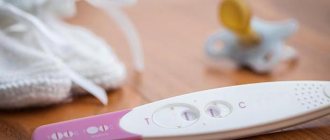Pregnancy at 36-37 weeks is a time that may well be the beginning of labor. The baby is already recognized as full-term and is completely ready to be born. Now he will only accumulate fat.
The woman’s body continues to actively prepare for the onset of labor, which is accompanied by the development of unpleasant symptoms. The bag with which the pregnant woman will go to the maternity hospital has already been packed.
During this period, mommy is advised to rest and not overload herself with household chores - entrust all matters to her family. The 36th week of pregnancy with twins can result in childbirth. The children are ready to be born. The twins will be under medical supervision after birth.
Child development
What happens to the baby at 36 weeks of pregnancy? No significant changes occur to the fetus: the baby is almost ready to be born. Organs and systems are fully formed and functional. The baby's genitals have also reached maturity.
Fetal development at 36 gestational weeks consists of weight gain. His shoulders and face have become pleasantly rounded due to the increased accumulation of subcutaneous fat. The weight of a child at 36 weeks of pregnancy can reach 2800 grams. But the baby can weigh less, about 2500 grams - and this is also the norm. His height reaches 47 cm.
The fetus at 36 weeks of gestation continues to prepare for birth. He actively trains and almost constantly sucks his fingers and toes, developing the sucking reflex. In addition, the baby regularly swallows the amniotic fluid surrounding him. At 36 weeks of pregnancy, the baby looks the way the mother will see him after birth.
The bones of the skull remain mobile due to open “springs”. They will drag on during the first year of the baby’s life, but for now the “soft” skull will make it easier for his head to pass through the birth canal.
As a rule, the baby at 36 weeks of pregnancy has already taken the desired position, turning head down. But if this is not the case, then an independent revolution can still occur, and the baby will take the necessary position. But if this does not happen, then the option of delivery by caesarean section can be discussed.
Questions - answers
I am 36 weeks pregnant - breech. Can the baby still roll over?
Usually by this stage of pregnancy the baby has already taken its final position. But you don’t need to worry: breech births go normally in most cases, but the tactics for managing them are slightly different. Your doctor will tell you the specifics and give recommendations. If there is a threat to you or the baby, a caesarean section may be performed if indicated.
I'm now 36 weeks. Is it possible to have sex at this time? My husband is worried, but nothing worries me, everything is going according to plan, there is no threat.
Sex at 36 weeks of pregnancy is acceptable if the pregnancy is indeed progressing normally. Just be careful, limit sudden movements, and don’t put pressure on your stomach.
Woman's feelings
36th week of pregnancy - what happens in the body of the expectant mother? The uterus rises above the pubic bone by 36 cm, which fully corresponds to the gestational age. Its bottom is located directly below the sternum - this is approximately 16 cm above the level of the navel.
The 36th obstetric week of pregnancy is characterized by the beginning of aging of the child's place. The placenta still copes with its duties, but doctors are closely monitoring its work.
Otherwise, fetoplacental insufficiency may form, and the child will receive less oxygen, as well as necessary nutrients. All the main sensations that a woman experiences at 36 weeks of pregnancy are caused by the approaching birth and an enlarged uterus.
The 36th week of pregnancy - if this is the second birth - may be accompanied by the appearance of their first precursors. In addition, a woman may have pain in the lower abdomen or directly in the perineum.
The cause of such sensations is the lowering of the baby's head into the pelvic cavity, accompanied by a slight divergence of the bones. In addition, the uterus puts pressure on the muscles and ligaments. A pregnant woman at thirty-six weeks may experience:
- cramps in the calf muscles;
- pain in the pubic area;
- feeling of heaviness in the lumbar area.
In a woman, due to the significant pressure of the uterus on the intestinal walls - after all, the weight of the fetus at 36 weeks of pregnancy is already quite significant - an exacerbation of hemorrhoids may occur. If this happens, then a doctor should select medications to relieve the symptoms of the disease. Women may experience:
- periodic soreness in the perineum, which they describe as shooting;
- Difficulty breathing – inability to take a deep breath. This is explained by the fact that the uterus has risen as high as possible and compressed the lungs. Therefore, the development of shortness of breath is possible even at rest. If the woman was able to take a deep breath deeply, then most likely the fetus began to descend;
- shortening and softening of the cervix, which is preparation for the upcoming birth. May be accompanied by slight tingling in the vagina. This is normal and there is no need to worry;
- Due to the stretching of the pelvic bones, a woman may experience slight discomfort.
But there are also improvements in the general condition. Heartburn disappears, and the stomach empties much faster after eating. The development of such sensations indicates that the baby has begun to descend and labor is getting closer.
The appearance of edema is possible. If they form in the evenings, after a long walk, and completely disappear by the morning, then this is the norm. There is no reason to worry. But if edema appears in the morning, and there is protein in the urine, there is a risk of developing gestosis - toxicosis in the second half of pregnancy.
The condition is considered dangerous for both mother and child, so the woman needs hospitalization. A woman may notice increased hair growth on her arms, legs, and even her stomach. The reason for this phenomenon is hormonal levels. After giving birth, all the extra hairs will fall out and everything will return to normal.
The prolapsed uterus puts pressure on the bladder, so the woman again has to urinate frequently. As a rule, the desire arises every hour. It is necessary to empty the bladder as soon as required, since stagnation of urine can cause infection.
Movements
Almost all pregnant women note a decrease in the child’s motor activity. The explanation for this is simple: there is not enough room for him in the uterus. But movements must be counted as before: within 12 hours, the baby must actively move at least 10 times.
Medical observation
From now on, you will have to visit your obstetrician-gynecologist every week. A number of tests will need to be done:
- General urine and blood tests;
- Examination of a smear to determine the microflora of the vagina;
- Blood test for HIV, syphilis, hepatitis B and C.
As usual, your doctor will measure your weight, blood pressure and fundal height at your appointment. At 35–36 weeks of pregnancy, ultrasound is performed only for special indications. It may be prescribed to determine the condition of the placenta, the volume of amniotic fluid and the location of the fetus in the uterus.
In addition, other studies may be recommended for the pregnant woman: Dopplerography (carried out to assess blood flow in the main vessels of the placenta and the baby) and cardiotocography (needed to assess the functioning of the fetal heart).
If necessary, the doctor will prescribe sanitation of the birth canal. To do this, you need to use special suppositories and vaginal tablets for 5–7 days.
Stomach ache
If a woman has a stomach ache at 36 weeks of pregnancy, then it is necessary to understand the reasons. Most often, this is caused by the pressure of the huge uterus on the ligaments that support it and the organs located in the immediate vicinity. Such pain is physiological and, in fact, the norm.
If a woman has pain in the lower abdomen, as during menstruation, or aching pain occurs, this may be a sign of oligohydramnios. You must inform your gynecologist about your condition. Sometimes expectant mothers complain that their lower abdomen is tight at 36 weeks of pregnancy.
The most common cause of the condition is a change in the position of the child. The stomach can be pulled due to the lowering of the fetal head into the pelvic area. For the same reason, a pregnant woman sometimes experiences lower back pain.
The stomach also pulls during training contractions, which almost all women experience. They will be felt as a short-term tension in the abdomen: the uterus briefly comes to tone, and then relaxes. This is the norm. But if contractions become regular, and the stomach begins to ache and ache, then this indicates the beginning of labor.
If your stomach hurts at 36 weeks of pregnancy, you should inform your attending gynecologist about it. But if the pain is accompanied by bloody discharge, then you need to urgently call an ambulance.
My stomach turns to stone
At 36 weeks of pregnancy, the stomach becomes stiff for many reasons:
- Bladder fullness. When filled, it puts a certain pressure on the uterus, which causes its excitement.
- Increased uterine tone. The stomach becomes hard at 36 weeks of pregnancy as a result of physical activity. In this case, the woman is recommended to lie down and rest. If the tone does not disappear, then it is advisable to consult a specialist.
In addition, the stomach may become hard at 36-37 weeks of pregnancy for other reasons. This:
- inflammation of the pelvic organs;
- diseases of the reproductive system;
- increased uterine tone caused by a stressful situation;
- prolonged physical activity;
- smoking, drinking alcohol, coffee.
What should the belly look like?
I looked at different pregnant women, all their bellies are different. And for a long time. I wondered: why does this happen, is it normal to have a small belly at 36 weeks? I scoured the Internet, studied various information, and received an answer. So, what does abdominal circumference depend on?
- From the presence of oligohydramnios (small belly) or polyhydramnios (large belly).
- May depend on the weight of the fetus.
- The individual structure of a woman’s body (most often this is the case) also influences.
One of the signs of imminent labor is a drooping belly. When does this happen? It is impossible to pinpoint exactly when this moment occurred. For some this will happen a few days before giving birth, for others a few weeks. A drooping abdomen is usually noticeable in a woman’s appearance: the belly hangs down, hardens, looks like an elongated pear, stretch marks grow on it, and the waist returns to its place. But this doesn't always happen. In this case, the expectant mother may notice signs accompanying this phenomenon:
- Heartburn disappears, as the uterus puts less pressure on the stomach.
- Breathing becomes easier, shortness of breath decreases.
- You can see how the distance between the stomach and chest has increased.
- Urination becomes even more frequent, because the uterus has descended lower and puts pressure on the bladder.
- The child began to behave quieter, calmer, he does not have enough space for active actions.
- Sometimes a woman loses a little weight.
And although it is becoming increasingly difficult for the expectant mother to do her usual activities because of her hanging belly, she still feels much better.
Women who have already given birth will understand what a cork is. Those expecting their first birth may be concerned about strange discharge. They look like a dense lump of grayish or yellowish color interspersed with blood. This mucus plug covers the cervix, protecting the baby's home from the penetration of pathogenic microorganisms.
Shortly before birth, it comes out, and the birth canal begins to prepare for the birth of the child. The plug may come out in one clot or in parts over several days. Sometimes it is released during childbirth itself. You can learn more about childbirth from the course “Giving Birth Successfully.”
Now I'm going to scare you a little again. Forewarned is forearmed. It is better to know in advance about some things, even if they are unpleasant, so it will be easier to avoid tragic consequences. I recently read about what Kuveler's uterine syndrome is. Find out about this too, my dear friends.
At any stage of pregnancy, placental abruption can begin. This happens for various reasons. This also happens at 36 weeks. The woman may notice bloody discharge. This sign should be a signal to immediately consult a doctor. The earlier a pathology is detected, the easier it is to treat.
As a result of placental abruption, hidden internal bleeding may develop; blood collects between the wall of the uterus and the placenta and leaks through the cracks formed into the abdominal cavity. This phenomenon is Kuveler's uterus.
The worst thing is that sometimes there are no symptoms of internal bleeding, the woman may not feel anything for some time, and in the meantime the situation worsens.
If such a situation is detected, emergency delivery is performed. If the bleeding cannot be stopped, the uterus must be removed. With Kuveler's uterine syndrome, the fetus suffers greatly because the placenta stops feeding it normally.
The child may experience severe hypoxia and die. Thus, in this tragic situation, a woman may lose her child, as well as lose the opportunity to ever give birth again.
Take care of yourself, dear women, be attentive to yourself, do not delay visiting a doctor if you have any alarming symptoms.
My article is coming to an end. I shared what I could with you. I hope you didn't waste your time on the pages of my blog. I will continue to try to please you with interesting and useful information. Come here more often, bring your friends. Subscribe to updates and receive all new articles first-hand. See you again, friends!
Vaginal discharge
Discharge at the 36th week of pregnancy becomes thicker in composition and increases in volume. The reason lies in the gradual removal of the mucous plug covering the cervix. It may come off in small parts and then pieces of dense mucus will be noticeable in the vaginal mucus. They may have blood streaks.
At 36 weeks of pregnancy, bloody discharge cannot be ignored. They can signal placental abruption, as well as the onset of labor. In both cases, the woman experiences pain of varying intensity.
Detachment of a child's place is a serious condition that poses a danger to both mother and child. In combination with increased uterine tone, placental abruption can lead to heavy bleeding.
You should immediately seek medical help if you experience liquid discharge, like water. This is amniotic fluid. If they pass away at once, then you need to go to the maternity hospital - this is the beginning of labor.
Amniotic fluid may be either completely clear or yellowish/greenish in color. It may leak in small portions, which indicates damage to the membranes. As a rule, a woman needs hospitalization. Any changes in the composition of the discharge should alert a pregnant woman, since the infection must be eliminated before labor begins.
Necessary studies and analyzes
At this stage of pregnancy, standard studies are carried out. A weekly visit to the gynecologist is mandatory. If your health changes, contact your doctor more often! Sometimes, to clarify the baby’s condition, an ultrasound may be prescribed at 36 weeks. You can ask to record photos or videos - the baby is already so old that it is very interesting to watch him!
Women's nutrition
Nutrition at 36 weeks of pregnancy should be less high in calories. It is necessary to exclude or at least reduce animal fats, as well as easily digestible proteins, from the diet.
In the last weeks of pregnancy, weight increases rapidly, which can negatively affect the course of labor. But don’t worry - the baby will still get all the substances he needs. The diet should contain:
- fresh vegetables and fruits (it is better to take local ones, avoiding exotic ones);
- porridge cooked in water;
- vegetable soups;
- fish and meat – boiled or steamed – low-fat varieties;
- compotes.
It is necessary to completely exclude:
- peanut;
- chocolate;
- smoked meats;
- pickles.
These products retain salt, which contributes to the development of edema. Pregnancy 36 weeks is a time that requires calm and focus. A woman should carefully monitor her feelings and follow all medical recommendations.
Feelings at 36 weeks of pregnancy
And yet, if everything goes according to plan, the pregnancy continues and - oh yes! – The baby is still growing and gaining weight. And although there is practically no room left in the uterus for active movements for the baby, the fetus does not stop moving and floundering. His movements are very noticeable to the mother, and you should continue to listen to them carefully. On average, a child should make himself known at least 10 times in 12 hours.
36 week pregnancy video
36 week pregnancy photo
The closer the moment of birth, the more anxious the mother’s soul is. Many women are afraid of the approaching “hour X”, become irritable and capricious, worry that the baby will be born healthy, and they will have enough strength and energy to care for him. These sensations are quite normal, but there is no point in dwelling on them: childbirth is a natural process, qualified medical staff always do everything in their power to help a woman get through this most important stage in her life.
The last weeks of pregnancy are usually not easy for mom: she is already tired from pregnancy, her big belly hinders her movements, her gait becomes heavy and ponderous, the woman feels clumsy...
There is just a little more patience left, and it is better if the remaining time for pregnancy is spent in calm and peaceful anticipation. Leisurely walks in the fresh air, good sleep and sufficient rest, a positive attitude will help you wait until the end of pregnancy and come to childbirth in peace and without irritation, which is important for the normal course of childbirth.
Weight at 36 weeks of pregnancy
A significant increase in weight at 36 weeks of pregnancy also causes certain inconveniences. At this stage, a woman could already gain weight up to 13 kg, and this weight may not even change before giving birth. Although, of course, in most cases, the weight increases even more until the end of pregnancy: the baby continues to grow, which affects the mother’s weight. Ideally, before giving birth, weight gain should not exceed 15-16 kg.
